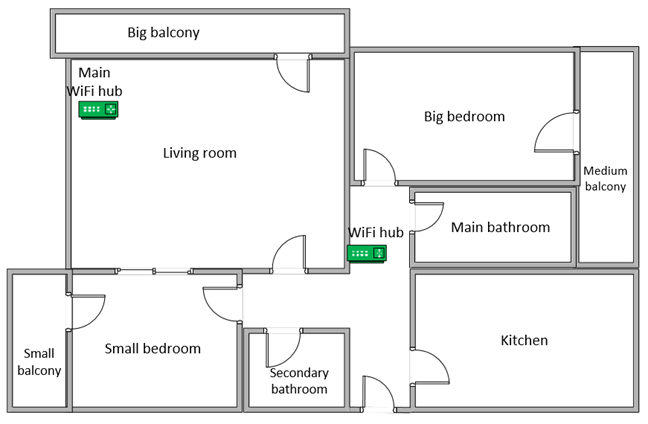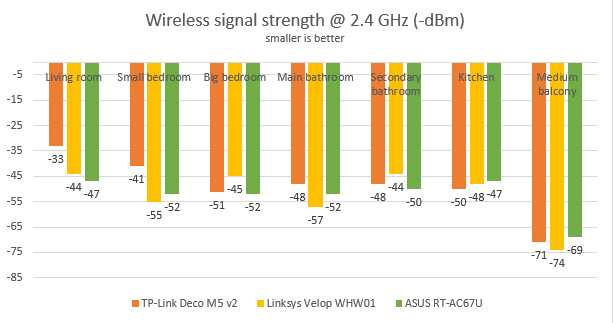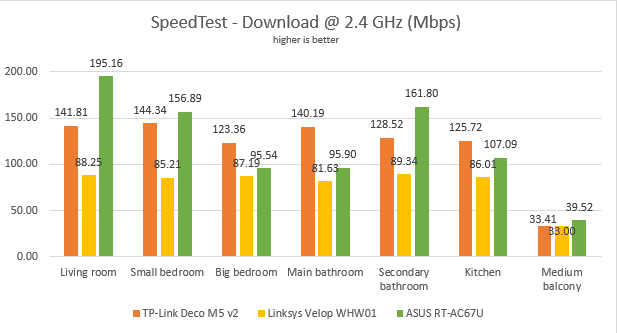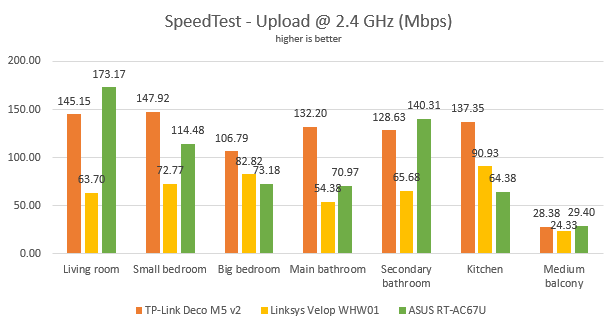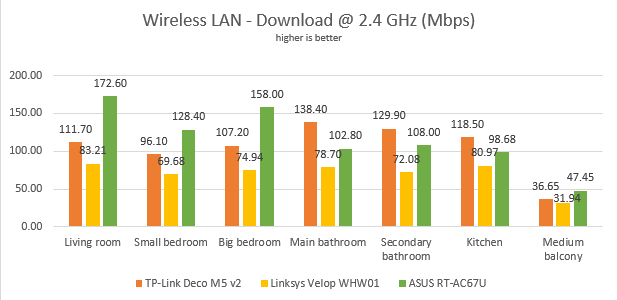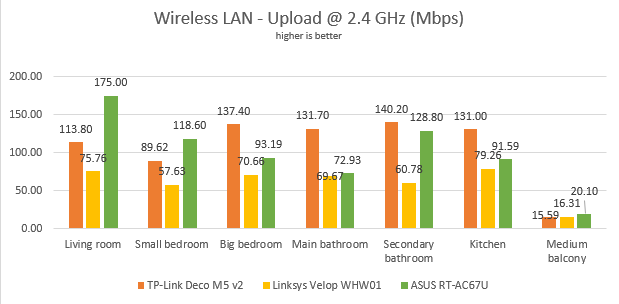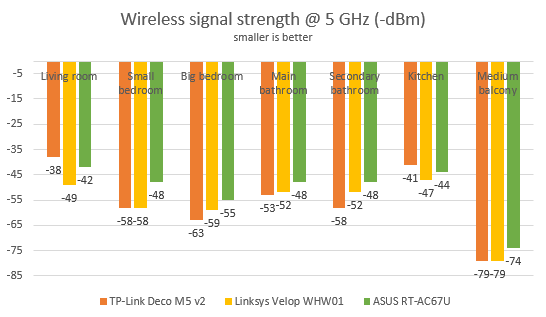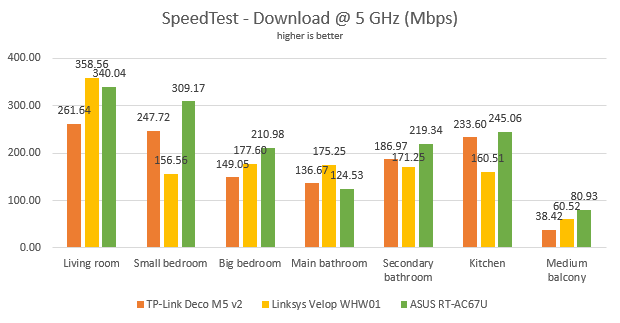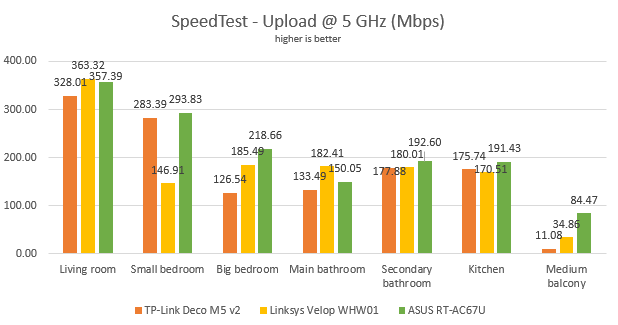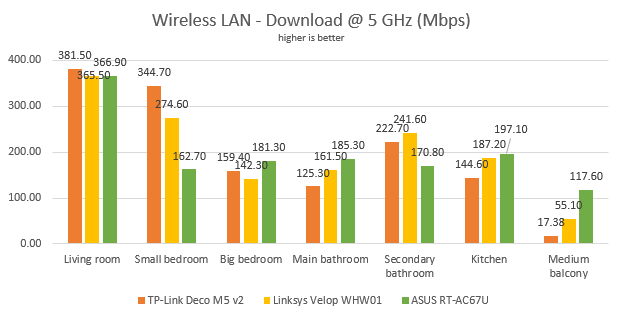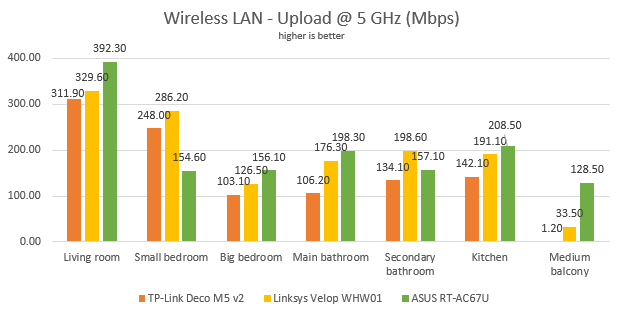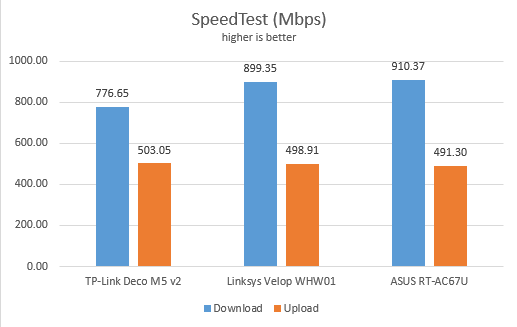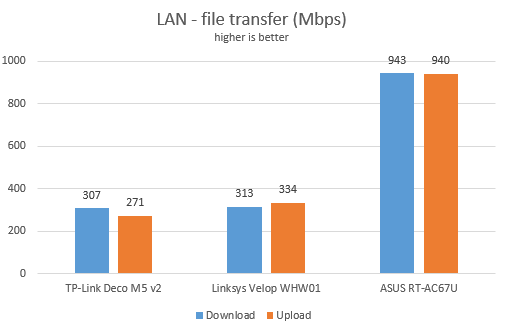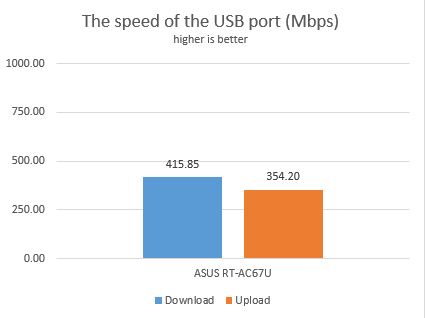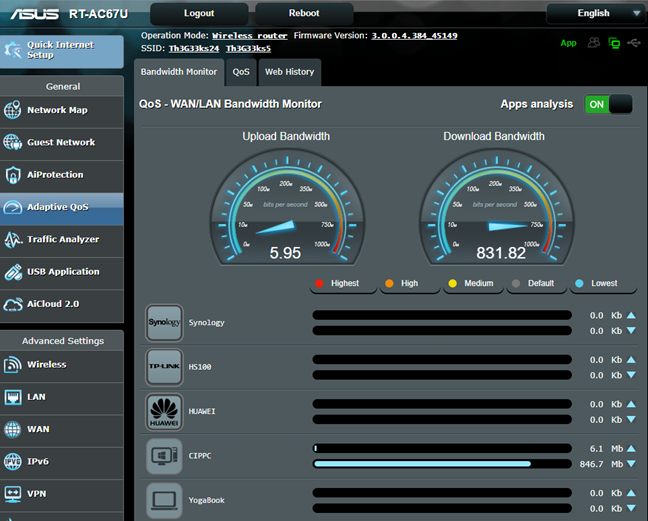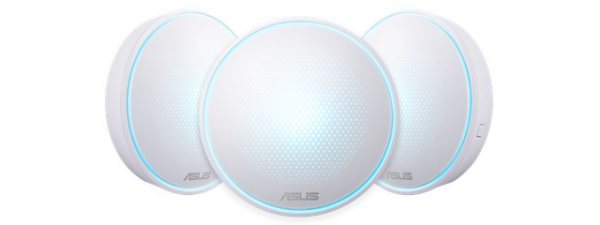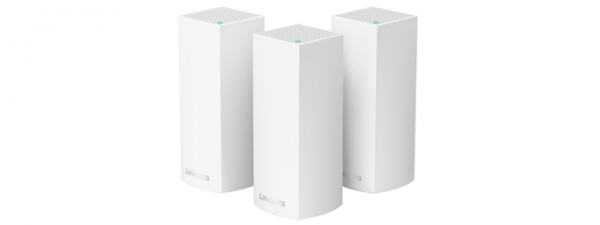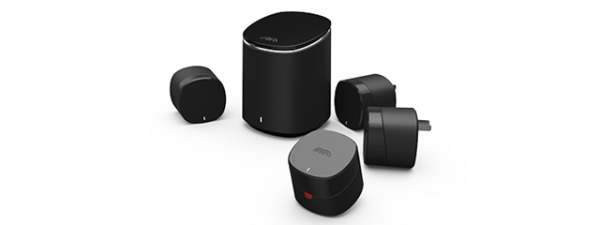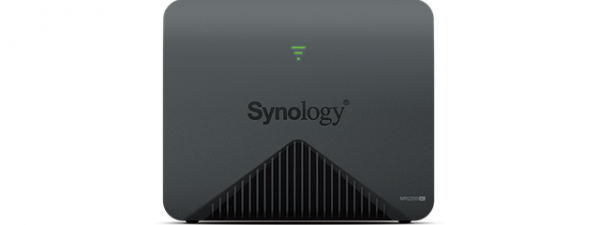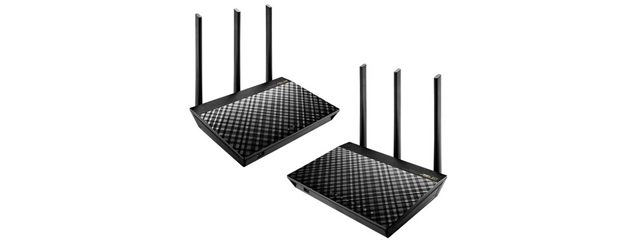
Wireless network performance
First, let's take a look at the apartment that was used in our testing and how it is set up. You can see that the central ASUS RT-AC67U hub is placed in the living room. When using wireless routers, the signal strength is not that high in rooms like the Kitchen and the Medium balcony. To improve the coverage of the network, we placed the second hub in the hallway, close to the entrance to the Kitchen, to cover most of the apartment, as well as possible.
Our testing was done using a fast 1 Gigabit Internet connection that is capable of uploads on the internet of up to 500 Mbps. We used an HP Spectre 13 laptop and a Lenovo Yoga Book for our measurements and several software tools.
We decided to compare the ASUS RT-AC67U with two competing mesh systems: TP-Link Deco M5 v2 and Linksys Velop WHW01 AC1300. Both of them are kits with two stations, just like the ASUS RT-AC67U.
We started by evaluating the 2.4 GHz wireless network and measured the signal strength offered in each room, using a tool named NetSpot Pro. You can see the evolution from room to room, in the graphic below.
We used SpeedTest to measure how fast the internet connection is when using 2.4 GHz band. ASUS RT-AC67U offered the fastest downloads in some rooms, while in others it was outperformed by its competition.
The same was true when measuring the upload speed with SpeedTest.
Continuing our measurements on the 2.4 GHz wireless network, we used the PassMark Performance test to transfer data between two computers connected to the network. Again, ASUS RT-AC67U offered the fastest downloads in some rooms, while in others it was outperformed by its competition.
When we measured the upload speed, we noticed a similar story.
ASUS RT-AC67U is capable of offering fast Wi-Fi on the 2.4 GHz band, without being the fastest mesh WiFi system. It has some tough competition that outperforms it in some measurements.
We then analyzed the performance of the 5GHz wireless band. We looked at the evolution of the signal strength, from room to room. ASUS RT-AC67U delivered solid signal strength in all the rooms of our apartment.
To see how fast the internet connection is when using the 5GHz band, we used SpeedTest. To view the maximum potential of this mesh WiFi system, we used a PCI-Express network card with support for 4x4 MU-MIMO. When we used this network card, we obtained a maximum speed of 470.49 Mbps for the download and 346.96 Mbps for the upload.
To get back to earth, and everyday devices people use, we took our laptops and measured the download speed with SpeedTest, in every room of our test apartment. In most rooms, ASUS RT-AC67U offered the fastest downloads, while in others it was outperformed by its competitors.
When we measured the upload speed, ASUS RT-AC67U had the lead in a slightly bigger number of rooms.
For the last measurements on the 5GHz wireless network, we used the PassMark Performance test to transfer data between two computers connected to the network. ASUS RT-AC67U offered fast downloads, but it was often times outperformed by the systems we compared it to.
When we measured the upload speed, ASUS RT-AC67U had very good performance on the 5 GHz band.
ASUS RT-AC67U is capable of offering fast Wi-Fi on the 5 GHz band, without being the fastest mesh WiFi system in all measurements. It has some tough competition that sometimes outperforms it.
Wired network performance
To test the quality of the wired Ethernet connection, we used a desktop PC equipped with an AMD Ryzen 5 1600 processor, running at 3.20GHz, 16GB of RAM, a fast Samsung 850 Pro 512GB SSD, and a Lenovo IdeaCentre 610s mini PC.
We measured the speed of the internet connection with a 1 Gbps Ethernet cable, using SpeedTest. ASUS RT-AC67U is faster than other mesh WiFi systems, due to the fact that it is composed of wireless routers.
Then, we ran a network transfer between the two computers, using the PassMark Performance test. Both of them were connected to the main hub in the ASUS RT-AC67U mesh. Other mesh WiFi systems have only two Ethernet ports, and one of them is used for connecting the mesh to the internet. Therefore, Ethernet transfers between nodes always go through Wi-Fi, not cable. As you can see below, ASUS RT-AC67U shows that, if you need Ethernet connections, it is better to go for the AiMesh approach, instead of traditional mesh systems.
ASUS RT-AC67U offers more Ethernet ports than most mesh systems. If you need to connect multiple clients through Ethernet cables, ASUS RT-AC67U gives you faster transfers and a better user experience.
USB performance
We connected a portable SSD drive to the USB 3.0 port on the main ASUS RT-AC67U hub. Then we ran a few transfers from a desktop computer to this drive and back. We measured a speed of 415.85 Mbps for the download and 354.2 Mbps for the upload.
If you use the ASUS RT-AC67U mesh Wi-Fi system, you get four USB ports: two USB 2.0, and another two USB 3.0. The USB 3.0 ports are reasonably fast but do not compare with what offered by other high-end wireless routers from ASUS and other brands. However, most mesh WiFi systems do not include a USB port, so ASUS RT-AC67U has the upper hand in this regard.
Extra features
Security is a significant feature of ASUS RT-AC67U, and it is all provided by the AiProtection module that includes:
- A comprehensive Router Security Assessment tool which verifies whether your router's settings are secure. When it finds problems, it proactively informs you and takes you where you need to fix things.
- Malicious Sites Blocking - an efficient cloud-based module that blocks malicious websites on all the devices that are connected to your network.
- Two-Way IPS - an improved two-way intrusion prevention system that protects all your network from spam, DDoS attacks, network attacks and more. Additionally, it also scans the packets that are sent from your network to the internet.
- Infected Device Prevention and Blocking - if your network devices get infected, and they become zombies in malware networks, they are automatically blocked by your router, and you are informed about this problem so that you can fix things.
- Parental Controls - some of the best you will find on wireless routers, with cloud-based filters for internet content, that do not need manual maintenance based on user-created block lists. You can also use them to schedule how much time your child's devices are allowed online every day.
The ASUS RT-AC67U AiMesh AC1900 Wi-Fi system also includes many other features that you may find useful:
- Guest Network - you can enable up to three wireless networks for each band, with individual security and access settings.
- Adaptive QoS - an intelligent QoS (Quality of Service) tool that you can use to analyze and prioritize network traffic efficiently.
- Traffic Analyzer - offers visual traffic statistics which give you a clear picture of how your network is used and by which devices.
- USB Applications - apps that are designed to work with all kinds of devices that you can connect to the router using USB: external hard disks, printers, and 3G or 4G dongles or modems.
- AiCloud 2.0 - a mobile app that keeps you connected to your data wherever and whenever you have an internet connection. With it, you can access the folders shared in your home network from your Android or iOS smartphone or via a personalized URL
- IPv6 - modern support for IPv6 addresses that are replacing IPv4.
- VPN - you can set the router to work as a VPN server, and you can also use it to turn your network-connected devices into VPN-enabled clients, without additional VPN software required.
- Network Tools - for analyzing the network and identifying what's wrong. They are useful when you need to troubleshoot problems.
- Dual WAN - excellent for both small businesses and professionals who require always-on Internet connections. You can also use a dual WAN to improve the quality of your internet connection and get the best possible performance.
- DDNS - a service that allows you to connect to the mesh system from the internet, even if your internet provider gives you a dynamic public IP address.
- Integration with Amazon's Alexa and IFTT (If This, Then That) - a service that automates tasks that might otherwise be repetitive or unable to talk to each other. With the help of these services, you can do things like "Alexa, ask ASUS ROUTER to upgrade the firmware" or get an email when your child gets home and connects his or her smartphone to the home WiFi.
The ASUS RT-AC67U mesh Wi-Fi system has many premium features and tools that are going to be useful to its users. Some of them are aimed at families, others at professionals, and many of them are useful to any user who wants security in their smart home.
What is your opinion of the ASUS RT-AC67U?
Now you know our opinion about the ASUS RT-AC67U AiMesh AC1900 WiFi system. Before closing this review tell us what you think about this kit. Do you find its features useful? Would you consider buying it? Comment below and let's discuss.


 20.02.2019
20.02.2019 